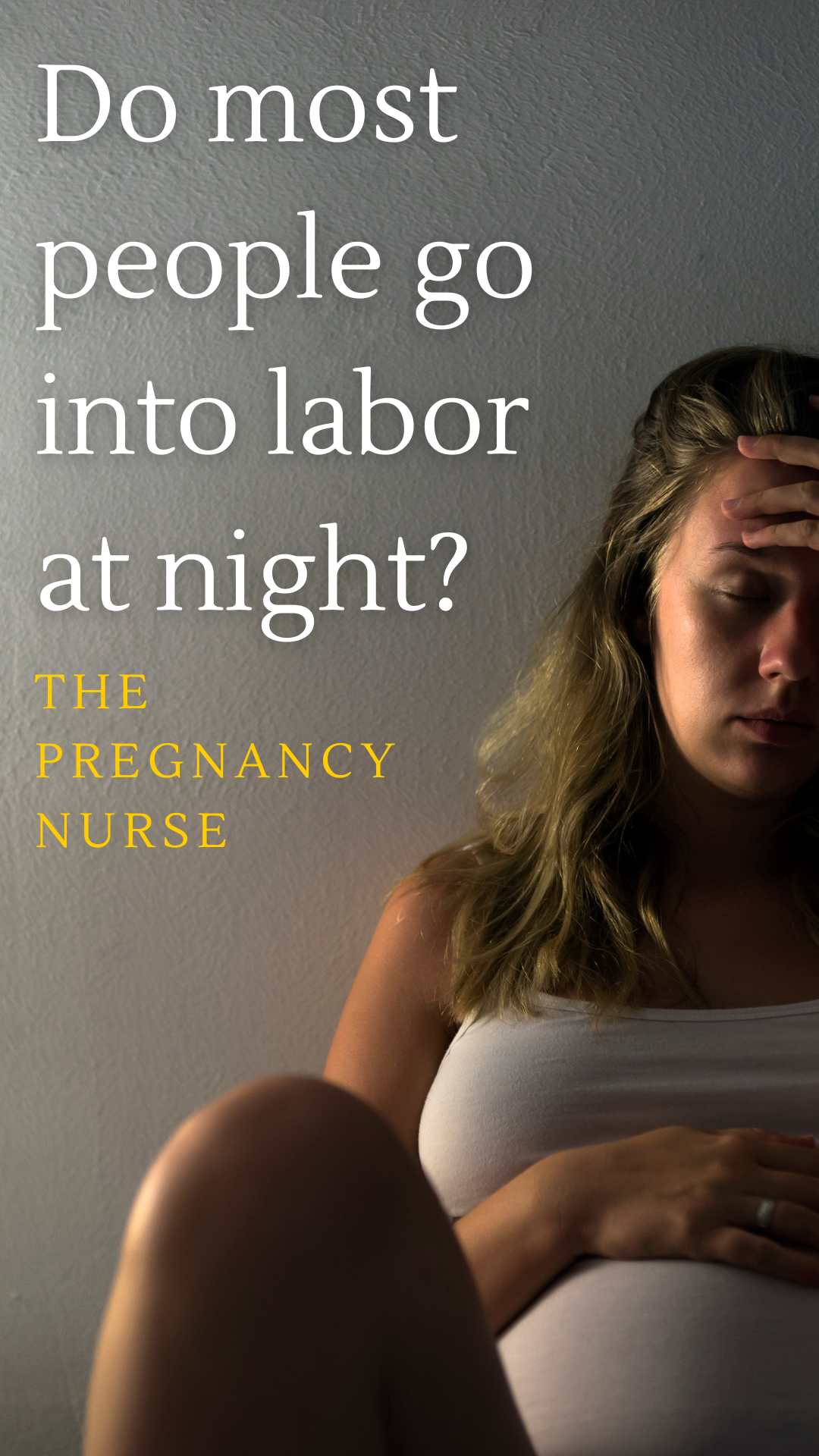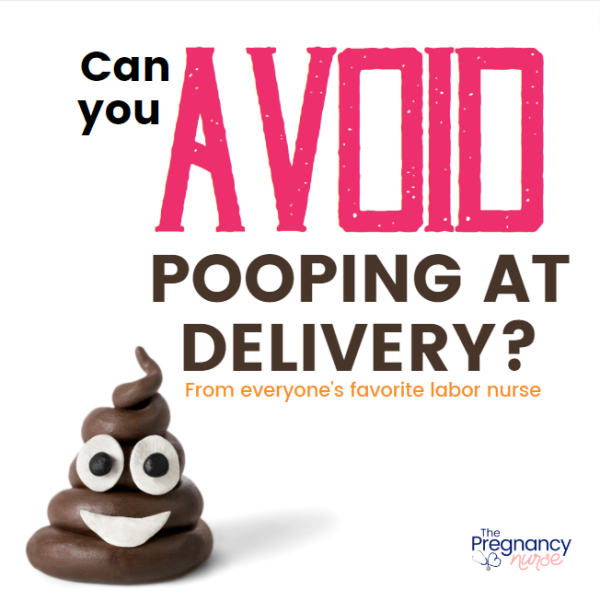👋 I’m so glad YOU are here. Are you looking to also get your partner prepared? This is for BOTH of you. Couples just love it and I know you want to both feel prepared!
You might be wondering if there is a time of day that you are more likely to start contractions than other times of day. Yes! Studies show more women go into labor at a certain time of day, and they have also shown when most people give birth — but follow an experienced nurse who shares WHY this might happen that way.

But first, how do I know so much about labor?
Hi, I’m Hilary — I’m The Pregnancy Nurse®. I’ve been a nurse since 1997 and I have 20 years of labor and delivery experience. I’ve seen thousands of women come in spontaneous labor, and also had a front row seat to how the hospital both supports that and also sometimes changes it. So, I’m an expert on this one.
When do most women go into labor?
This study from the University of London (that looked at over five million births) showed that women that go into spontaneous labor (continuing to a spontaneous birth) have their babies between midnight and 6 am. And most labor start around 2 am in the wee small hours of the morning.
We aren’t entirely sure what prompts a body to go into labor, but that retrospective study showed that was the most likely time for sponatneous labor — but the study also showed how obstetric intervention changed birth times, so keep reading to learn more.
And, if you want to know more about the in’s and out’s of labor (especially doing it with your partner) come join me in here!
Why does a lot of labor start at night?
We don’t really know, but the idea is oxytocin flows as you get comfortable in bed. They also believe melatonin may play a role in in making the oxytocin more potent to the uterine muscle.
This study showed that primates also go into labor at night due to their circadian rhythms.
It makes sense that animals birth at night as it would offer the newborn baby some protection when they are most vulnerable right after birth from predators. And labor and birth probably afforded mama some protection in the dark as well. So, for animals there’s more at play than just circadian rhythms. And luckily, no animal is trying to attack you after birth!
Personally, I believe partners are home, women feel safe and relaxed. Their body is tired from a full day of work and is finally able to relax and let the uterus do it’s thing. Partners come together in bed to rest at night and that helps oxytocin flow as the patient relaxes.
Looking to get prepare for your birth? I have some easy options for you!
~~~~~~~~
– Worried you’re missing something? Grab my pregnancy planner so you don’t miss a thing!
– Thinking about an induction? Grab Inductions Made Easy to feel prepared in just 20 minutes!
– Wondering how to get that baby OUT? Grab Going Into Labor Made Easy so you know how to (and not to) do it!
– Postpartum got you anxious? Check out Postpartum Care Made Easy so you can stay SAFE even when all your attention is on that little on.
🚨 AND if ALL OF IT has got you on edge The Online Prenatal Class for Couples is perfect for you — You’ll feel so ready before you even know it!
~~~~~~~~
No matter WHERE you are at in your pregnancy journey, we have resources that can help!
What sleeping position helps you dilate?
There isn’t a particular position that really helps, but I have a post on the best sleeping positions to induce labor that you might find helpful.
What time of day are most babies born?
Beyond most births happening between midnight and 6 am, the study had a few other nuggets for us.
An interesting fact in that one was that 71.5 percent of births occur outside of “working” hours (meaning while the doctor’s office would be open).
That study showed that other births (not spontaneous labor) delivered at different times:
Cesarean births were mostly on weekday mornings (which is when hospitals much prefer to schedule them for safety).
Induced births were most often around Midnight from Tuesday to Saturday, and on days just before a public holiday (and less likely on Sundays, Mondays and public holidays).
I found it interesting that 7% less babies are born on Christmas day and Boxing Day than on other days (this was a British study). This makes sense as neither patients or staff want to deliver babies on Christmas (although plenty do still come).
If you’re close to having your baby — be sure to grab my hospital bag packing list:
Why Do Hospitals Change Birth Times?
{that heading reads weird, — I mean that hospitals and interventions sometimes change when birth occurs}
Some people read this study and are bothered by how hospitals change birth times.
I have few thoughts on that after working at the hospital for so long:
Cesareans Are Best Done When Everyone Awake and Alert
I would hope we all agree that it’s fine that people want their provider alert and fresh as possible when they do their cesarean. That is something we can plan or pick when we schedule them, so they often happen early in the mornings. Also, often they ask you not to eat prior to it for a few hours, so most patients prefer an early morning one as well.
Inductions Change Birth Times
Obviously, they pick times that will be convenient to the patient and staff when they schedule an induction, and for larger hospitals those inductions are dispersed during the day (not all at once). They also try not to make the deliveries in the middle of the night if possible. It just helps keeps doctors sane, and frankly better for patients if they are able to try to get some sleep after deliveries.
Also, patients like the idea of scheduling a time to come in and go into labor (moms who have other kids, like being able to drop those kids at a safe space and then go into labor with an induction). It’s one of the perks of modern medicine!
Epidurals Change Birth Times
When you have an epidural you may not have as big of an urge to push, and the doctor may be able to delay the birth a bit if they need to finish something in the office, or get in after a night’s sleep. I see more deliveries at the end of office hours (around 5 pm) and before office hours start, right as the provider wakes up (so like 6 or 7).
Of course, as soon as we think we have a plan in labor, mother nature goes about messing with it. So, even if a provider thinks a patient will have a long induction and plan for you to come in the night before you’ll have the baby mother nature may push you into labor faster and your provider delivers during the middle of the night.
Want to know more about birth plans? — I have a whole video on them in my free prenatal class you might enjoy.
How Shift OB Work Changes Birth Times
When I started in labor and delivery, a good number of doctors had their own practices and did most of their own deliveries. Sure, they went out of town now and then, or sometimes had other doctor’s cover for a child’s performance or something, but for the most part they were chained to the hospital and their deliveries.
They also ran office hours during the day and tried to run deliveries around seeing patients (leaving many patients with lots and LOTS of reschedules).
Now, many doctors work in a group and just take call a few times each month. That means they aren’t doing office hours at the same time (they’re just at the hospital), and also that they’re able to have the day off after working all night doing deliveries.
It also means that they’re not up every night doing deliveries, just a few times each month which allows them to get rest, and have hobbies, and see their families. Perhaps to be a more well-rounded human being.
Some patients don’t love this — they want their doctor to deliver them. However, I truly think the trade-off of having providers who truly love their job and don’t feel chained to it is well worth maybe not knowing you delivers you.
Pro Tip: You mostly see your nurse in labor, not the doctor.
Also, these providers don’t try as hard to “aim” deliveries to deliver during the day when their office isn’t open. They’re fine to deliver the patient whenever, because they are at the hospital already (and they know they’ll have the next day off to rest).
It’s just something to be aware of in the changing landscape of obstetric providers.
Laboring at Night FAQ’s
Can Labor Start While You’re Sleeping?
Yes, many times patients may feel the cramping now and then, but are able to get some sleep in early labor if they can get in a comfortable position. But, eventually labor will wake you up I find. I have a whole post that answers can labor start while sleeping.
Can labor start and stop over days?
Annoyingly so, yes. Contractions may come in the evening and then stop while you’re asleep.
This happened to me. It was super annoying. I fee like it was just maybe me feeling contractions once I could finally lay down after doing 2 other kids all day, or maybe not being as hydrated at night (so I wouldn’t pee all night). Who knows, but I know lots of friends this has happened to also.
What are Braxton Hicks contractions?
Some people call them false labor, or practice contractions also. Either way they are contractions that don’t push baby into the birth canal and don’t progress labor.
Of course, at any time these might go all the way into labor, and I differentiate between true and false labor more in my post on the signs of labor.
Does the hospital stall labor at night?
Often people will come into the hospital in a great labor pattern and then “stall” out once they are there. There is a lot of conversation that this is due to our lighting.
So, if you’d prefer the lights off (when not necessary — don’t ask your nurse to put your IV in the dark) just let your provider know. Every patient is different, so we try to make you as comfortable as you can. Some patients prefer the lights on being in a new place, and that is fine too.
There may be other reasons this happens. I think the key is to try to stay as relaxed as possible, and if there is anything that the hospital can do to help you feel more relaxed, feel free to ask if they can accommodate you.
I don’t want to have my baby in the middle of the night – help!
I get this feeling too. You’re up all night laboring, and then have your baby early in the morning and then you’re just so tired. It is sort of miserable, but my best tip is to get some rest soon after your “golden hour” is over. Baby will be sleepy then too and you guys can likely get a couple of hours of good rest before baby needs to eat again.
Your new life is run on a 24 hour clock at this point, so get rest when you can.
I give more great tips on managing life in the hospital like this one in here.
So yes, you may be more likely to go into labor and give birth at night, but it always depends on what happens for you, not really what the study reveals. Women give birth when it’s right for them (although interventions are most likely to change that time). BUT I think it’s important for patients to have this information so if they contract and night they know it’s not unsuual. I recommend trying to get some sleep — contractions may get worse, or they may peter out, only time will tell.
But, if you want to relax your mind about labor and birth, come join me in The Online Prenatal Class for Couples where we get both of you prepared in just a few hours.

And, if you’re not quite sure you’re ready for that whole thing, check out my free prenatal class. It’s your first step toward getting in the driver’s seat of your birth.
Don’t miss my super helpful post all about the signs of labor. Great info for pregnancy!







 Best Time to Get an Epidural During Labor
Best Time to Get an Epidural During Labor

Mine is over 40 weeks am scared